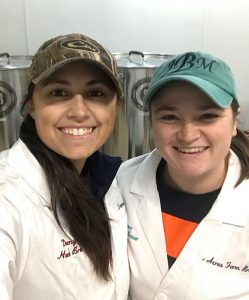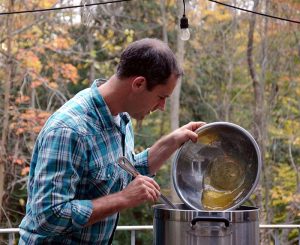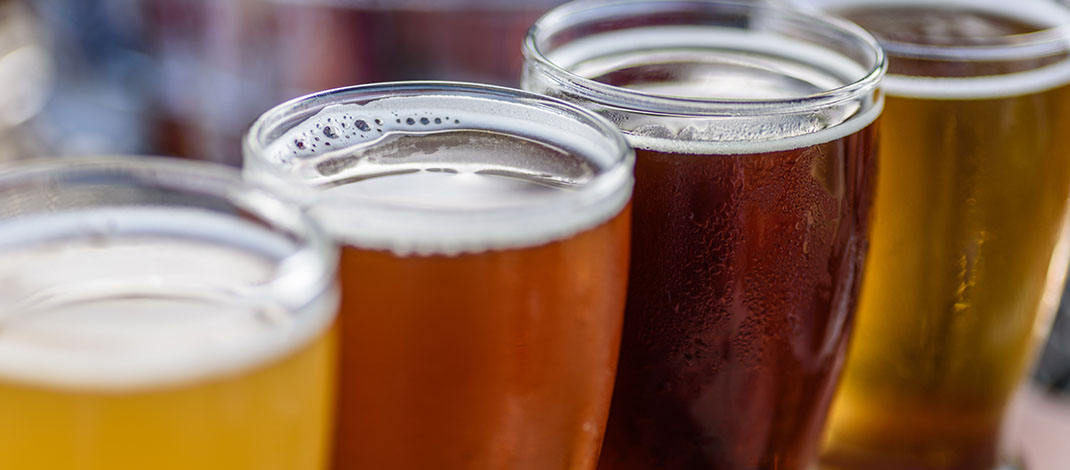By Ken Sturtz
Earlier this year when officials announced the semifinalists of a small business development competition in Oswego County it was clear that tapping into the craft beverage industry was a common theme among the entrepreneurs.
Five of the 14 semifinalists for the Next Big Idea contest proposed producing and selling alcohol in some form: artisanal ales, draft mead, hard cider, fruit-infused beers.
The state’s craft beverage industry has grown tremendously in the last decade. New York now has the fourth most wineries, third most distilleries and second most breweries in the country. The number of licensed manufacturers has grown 157% since 2012, to more than 1,200. As of October, the State Liquor Authority counted 500 breweries, 485 wineries and 203 distilleries, as well as 75 producers of hard cider.
Such a breathtaking pace inevitably raises questions about just how much room exists for the industry to grow before the market becomes saturated.

“There’s certainly room for more growth,” says Paul Leone, executive director of the New York State Brewers Association. “Is there a ceiling? I’m sure there is, but it’s not clear where the ceiling is.”
Craft breweries have grown 415% since 2012 when fewer than 100 existed. Before the coronavirus pandemic breweries were opening in the state at a rate of one every eight or nine days, Leone says. The pandemic slowed things, but several dozen breweries still opened in 2020.
Leone says the state could probably support 100 more breweries before the industry begins to see a slowdown. New York’s breweries tend to be smaller mom-and-pop operations that can survive in a relatively small geographic area, he says.
And while there are heavy concentrations of breweries in Long Island, the Hudson Valley and the Finger Lakes, other parts of the state remain largely untouched.
Leone cited Wayne County, which has two tasting rooms, but is getting its first actual brewery. The county’s 90,000 residents could easily support many more breweries, he says. Oswego County has just a handful of craft beverage producers; Onondaga County has dozens.
The Farm Winery Act
The craft beverage industry in New York didn’t take off by accident. It was in large part the product of long-term efforts by the state to expand the sector beginning with wineries.
The wine business in New York was long dominated by a handful of larger wineries. Hundreds of small grape growers made a living selling most of their crop to those large companies.
But by the 1970s those farmers faced a crisis. Several large wine businesses in the state consolidated and were acquired by corporate interests that sought cheaper grapes. A couple businesses went under. And cheap imported wines began pressuring the domestic wine industry.
With few options for selling their grapes, the solution was to turn them into wine. But grape growers were essentially forbidden from making wine and selling it directly to consumers. Under the state’s three-tier system, wineries had to sell 95% of their production through a distributor or wholesaler who then sold to retailers.
So, in 1976, the state passed the Farm Winery Act. The law created a category known as farm wineries — until then all wineries were classified solely as commercial. Provided they sourced their fruit locally, farm wineries could sell their whole output to the public at the winery and directly to retailers and restaurants, bypassing wholesalers.
![Chris Gerling is senior extension associate at Cornell University’s Craft Beverage Institute. “The Farm Winery Act [of 1976] was kind of revolutionary because it allowed people to produce, sell and be wholesalers if they wanted,”](https://www.oswegocountybusiness.com/wp-content/uploads/2021/12/Chris-Gerling-229x300.jpg)
The result was a successful model for unprecedented growth. There were fewer than two-dozen wineries in the state in the mid-1970s; today there are 485.
“This became a real bright spot for Upstate agriculture and tourism,” Gerling says. “It really helped a lot of the communities that were having Rust Belt decline.”
Is a Slowdown on the Horizon?
Craft brewing became popular in the 1990s and about a decade ago the state followed the same model it had created for wineries, expanding its farm producer licenses to include brewers and distillers. The state also cut fees and regulations and offered grants and tax incentives. As with wineries, craft producers have to source their ingredients in New York state.
The number of breweries and distilleries began growing. In addition to changes to the law, the craft brewery boom has been driven by younger consumers looking to support local businesses that make products with locally sourced ingredients.
“Millennials are really conscious of those things,” Leone says. “So, it was really a perfect storm for growth.”
Despite the growth, however, even some entrepreneurs entering the craft beverage industry have wondered if the pace is sustainable.
Jenna Behling’s family owns several hundred acres of orchards in Mexico where they grow apples as well as raspberries, cherries, strawberries and blueberries. They sell apples wholesale and offer U-pick. Behling says her family was looking for ways to expand the business and became interested in producing craft beverages.
“We were wondering about the brewing industry as well and there’s been a big debate over whether it’s saturated,” she says.
They started out home brewing four or five years ago with one-gallon testers on their kitchen stove. They brought in a head brewer, set up a one-barrel system and began experimenting.

In the fall when people flood their orchard and farm stand they sell fruit-infused beer under their 6 Acres Farm Brewing label. They also sell kegs to local restaurants. They’re producing 13 unique recipes of beer and experimenting with several others.
Behling, who entered and won the Next Big Idea contest, plans to use the $50,000 prize money to help scale up production. She says they’re in the process of opening a tasting room. They currently sell growlers of beer, but she says they hope to eventually acquire canning equipment to allow for easier distribution.
As for whether the craft beverage industry is saturated, Behling says she believes there’s room for it to continue growing, at least in Oswego County where there aren’t other farm breweries.
“It’s not like there’s five or six of them in this area,” she says.
Clusters of breweries isn’t necessarily bad for business, Leone says. Consumers who enjoy craft beer usually prefer to visit several establishments in an outing and will often choose an area with multiple breweries.
“If one brewery opens, that’s great,” Leone says. “If three open, then it’s a destination.”
Diversification
In the Finger Lakes the number of wineries, breweries and distilleries has skyrocketed, raising concerns about whether the businesses will eventually cannibalize each other.
Decades ago on Seneca Lake there was a winery about every five to seven miles, Gerling says. Today there are so many wineries that a tourist would need days to visit them all.
“It’s just astounding how many places there are for a person out for the day to stop,” Gerling says.
Even with more tourists visiting the Finger Lakes, businesses are likely to see fewer customers than they might have decades ago. There is an upside though. Greater competition has led many businesses to fine-tune their focus to the benefit of customers.
In the past a business might have gotten more customers, but they were often just touring without anything in mind other than visiting some wineries, Gerling says. Today customers are much more focused. They might seek out a business that specializes in IPAs, hard cider or that produces certain types of wine.
“There’s a little more choice and selection,” Gerling says. “Consumers have better experiences and they tend to spend more at the places they choose.”
Diversification in the craft beverage industry hasn’t just taken place in the Finger Lakes. Across the state winemakers, brewers and distillers have increasingly narrowed their focus and searched for a niche.
Hard cider, for example, has made a startling comeback. Historically cider was once on par with beer in terms of popularity in the United States. The drink faded in the early 20th century, but New York now has more cideries than any other state.
Hard cider isn’t the only example of diversification of the craft beverage industry.
Jonathan Shaver is looking to capitalize on a new take on an old drink. Mead has been around since ancient times. Although there are many variants, mead was traditionally something akin to a sweet honey wine with a high alcohol content.
“It’s not a mainstream beverage anymore like it used to be centuries ago,” Shaver says.

Shaver’s business plan for Feral Hive Meadworks was a semifinalist in the Next Great Idea contest. He’d like to establish a facility to produce a carbonated draft version of mead with a lower alcohol content and a flavor profile similar to hard cider. He says he plans to open a tasting room in Oswego once he receives the necessary licenses.
Shaver is an electrical engineer at Nine Mile Point Nuclear Station and a commander in the Navy Reserve. He became interested in mead when two hobbies intersected. A few years ago, he started beekeeping, maintaining hives at his home. He had also brewed beer at home. The first time he tried mead he didn’t like the taste.
“I thought it was a really sweet syrupy flavor and I did not like it at all,” he says.
He began experimenting with fermenting mead to see if he could scale back the alcohol content and the sweetness to get a more accessible flavor profile people would like. He eventually landed on a recipe he and his friends enjoyed.
“It definitely is in line with what people are looking for especially in the craft industry,” he says.
Although the public isn’t familiar with mead, that might be beginning to change. A handful of meaderies have started popping in recent years; nine now dot the state.
The Next Phase
One of the reasons the state has been able to absorb so much growth in the craft beverage industry is that while the overall number of businesses has risen dramatically, many are quite small and produce far less actual volume than people expect, Gerling says.
“It’s relatively easy to start a locally successful business where you don’t have to get into the wholesale market,” he says.
A small craft beverage maker can sell a $20 product directly to consumers and keep all the money. When wholesaling, that same $20 product might only return $8 to the business owner. Of course, businesses make up for that when they scale up production.
But in some ways scaling up from a mom-and-pop operation to become a larger producer is the Achilles’ heel of New York’s craft beverage industry.
“Wholesale is a very difficult market,” Gerling says. “It becomes increasingly necessary because as you become successful there’s only so much you can push out of one place.”
Competition for limited shelf space in stores has increased. Distribution and the ability to consistently produce enough volume to meet orders pose added challenges. In some ways it’s fairly easy to be a small or large business in the industry, Gerling says. It’s the medium-sized businesses that have the greatest difficulty.
“They’re not failing, but they’re not growing as they’d like to be,” he says. “They’re not reaching the next phase basically.”
It also depends on what a business owner’s goals are, Leone says. Some breweries have experienced great demand for their product and want to work with distributors and scale up their production. Many are content to stick with their current business model of selling most of their product directly to customers via a tasting room.
The notion of a small local craft beverage producer is a large part of the appeal, Gerling says. In many ways it’s a throwback to a time before national distribution when every small town supported a handful of small businesses including a brewery and a pub.
“It’s either totally new or it’s getting back to where we were 150 years ago,” he says. “There are some things that are very new and some things that are very old and I think that’s an attractive combination to people.”




